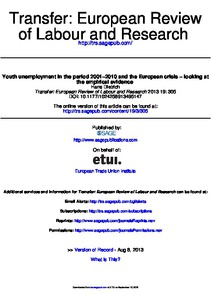Youth unemployment in the period 2001–2010 and the European crisis – looking at the empirical evidence

Transfer. European Review of Labour and Research
2013
19
3
August
305-324
business cycle ; economic recession ; youth employment
Employment
http://dx.doi.org/ 10.1177/1024258913495147
English
Bibliogr.
"This article examines the development of youth unemployment in the period 2001–2010 from a macro perspective. As dependent variables, alternative concepts of measuring youth unemployment are introduced. Whilst the traditional youth unemployment rate responds best to business cycle effects, improvement of the overall education level, or growth of the share of industrial employment, it does not respond to the relative growth of inactive young people. As alternatives, the NEET ratio and the share of unemployed in the youth population are employed, which both relate unemployment or joblessness to the youth population. Compared to the NEET model the latter model is more sensitive to the change in size of the inactive youth population and delivers good explanatory power. Finally, the ratio of youth unemployment to the corresponding adult rate was tested, and found to have increased in the 2000s until 2008. In the years of crisis, however, this ratio stagnated or decreased even slightly. Generally speaking, the development of this ratio seemed only to be weakly connected to the business cycle in the 2000s, something which should be further researched. Possible consequences for political action are discussed. "
Digital;Paper
The ETUI is co-funded by the European Union. Views and opinions expressed are however those of the author(s) only and do not necessarily reflect those of the European Union or the ETUI.